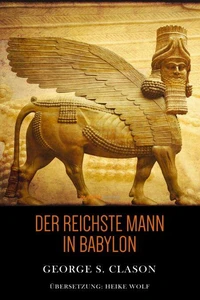The Richest Man in Babylon
Par : ,Formats :
Disponible dans votre compte client Decitre ou Furet du Nord dès validation de votre commande. Le format ePub est :
- Compatible avec une lecture sur My Vivlio (smartphone, tablette, ordinateur)
- Compatible avec une lecture sur liseuses Vivlio
- Pour les liseuses autres que Vivlio, vous devez utiliser le logiciel Adobe Digital Edition. Non compatible avec la lecture sur les liseuses Kindle, Remarkable et Sony
 , qui est-ce ?
, qui est-ce ?Notre partenaire de plateforme de lecture numérique où vous retrouverez l'ensemble de vos ebooks gratuitement
Pour en savoir plus sur nos ebooks, consultez notre aide en ligne ici
- Nombre de pages105
- FormatePub
- ISBN978-2-38037-269-4
- EAN9782380372694
- Date de parution03/06/2020
- Protection num.Digital Watermarking
- Taille283 Ko
- Infos supplémentairesepub
- ÉditeurPocket Classic
Résumé
The parables are told by a fictional Babylonian character called Arkad, a poor scribe who became the "richest man in Babylon". Included in Arkad's advice are the "Seven Cures" (or how to generate money and wealth), and the "Five Laws of Gold" (or how to protect and invest wealth). A core part of Arkad's advice is around "paying yourself first", "living within your means", "investing in what you know", the importance of "long-term saving", and "home ownership".
The content is from a series of pamphlets distributed by U.
S. banks and insurance companies in 1920-24; the pamphlets were bound together and published as a book in 1926. The book is often referred to as a classic of personal financial advice, and appears in modern recommended reading lists on personal financial advice and wealth management, which has kept the book in print almost 90 years after its first edition with over 2 million copies sold. Clason himself published an illustrated hardback edition in 1930 titled The Richest Man in Babylon and Other Stories which now sells for USD 1, 250. The unusual structure of the book has inspired many modern derivative works providing further discussion and insights on the parables.
S. banks and insurance companies in 1920-24; the pamphlets were bound together and published as a book in 1926. The book is often referred to as a classic of personal financial advice, and appears in modern recommended reading lists on personal financial advice and wealth management, which has kept the book in print almost 90 years after its first edition with over 2 million copies sold. Clason himself published an illustrated hardback edition in 1930 titled The Richest Man in Babylon and Other Stories which now sells for USD 1, 250. The unusual structure of the book has inspired many modern derivative works providing further discussion and insights on the parables.
The parables are told by a fictional Babylonian character called Arkad, a poor scribe who became the "richest man in Babylon". Included in Arkad's advice are the "Seven Cures" (or how to generate money and wealth), and the "Five Laws of Gold" (or how to protect and invest wealth). A core part of Arkad's advice is around "paying yourself first", "living within your means", "investing in what you know", the importance of "long-term saving", and "home ownership".
The content is from a series of pamphlets distributed by U.
S. banks and insurance companies in 1920-24; the pamphlets were bound together and published as a book in 1926. The book is often referred to as a classic of personal financial advice, and appears in modern recommended reading lists on personal financial advice and wealth management, which has kept the book in print almost 90 years after its first edition with over 2 million copies sold. Clason himself published an illustrated hardback edition in 1930 titled The Richest Man in Babylon and Other Stories which now sells for USD 1, 250. The unusual structure of the book has inspired many modern derivative works providing further discussion and insights on the parables.
S. banks and insurance companies in 1920-24; the pamphlets were bound together and published as a book in 1926. The book is often referred to as a classic of personal financial advice, and appears in modern recommended reading lists on personal financial advice and wealth management, which has kept the book in print almost 90 years after its first edition with over 2 million copies sold. Clason himself published an illustrated hardback edition in 1930 titled The Richest Man in Babylon and Other Stories which now sells for USD 1, 250. The unusual structure of the book has inspired many modern derivative works providing further discussion and insights on the parables.




